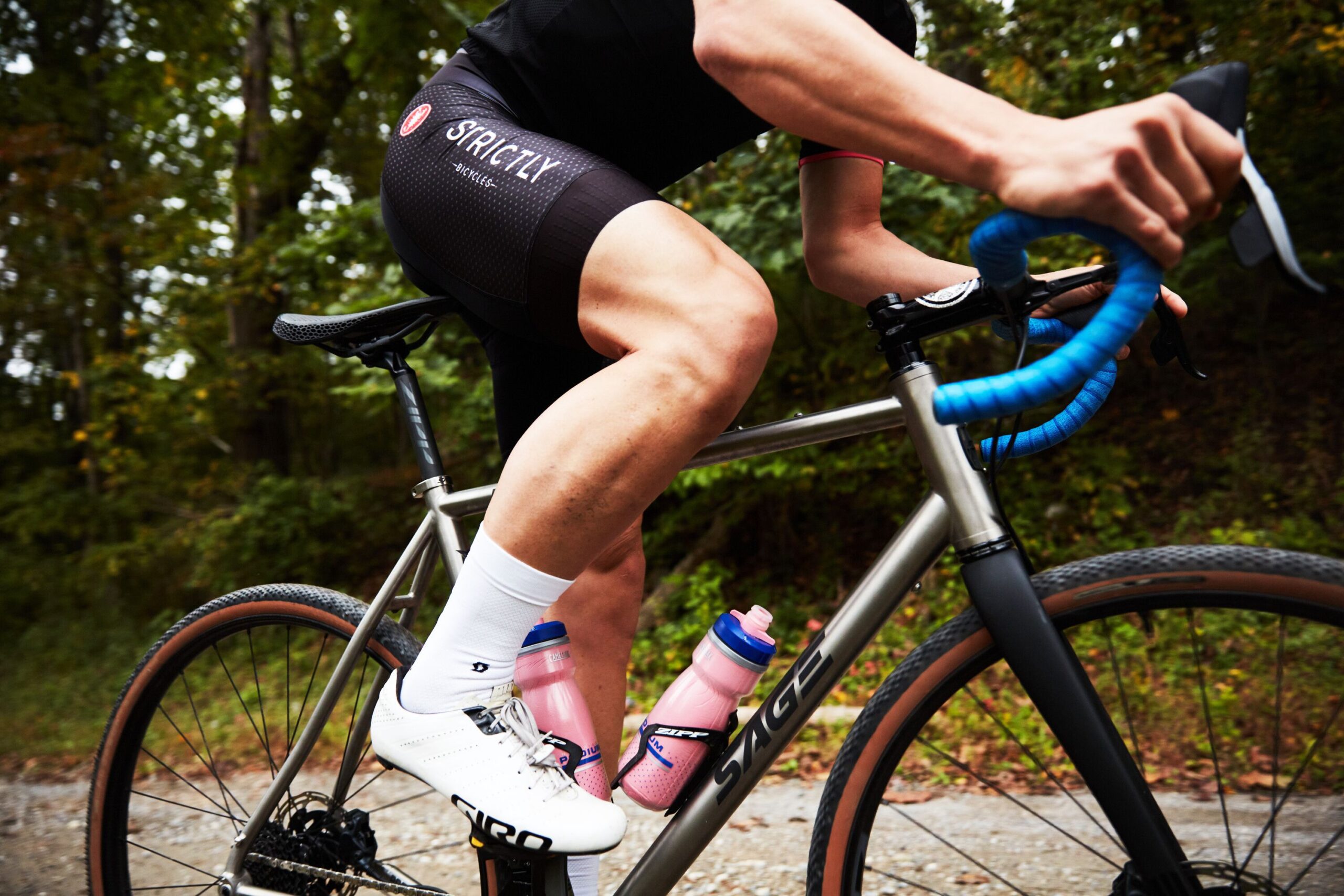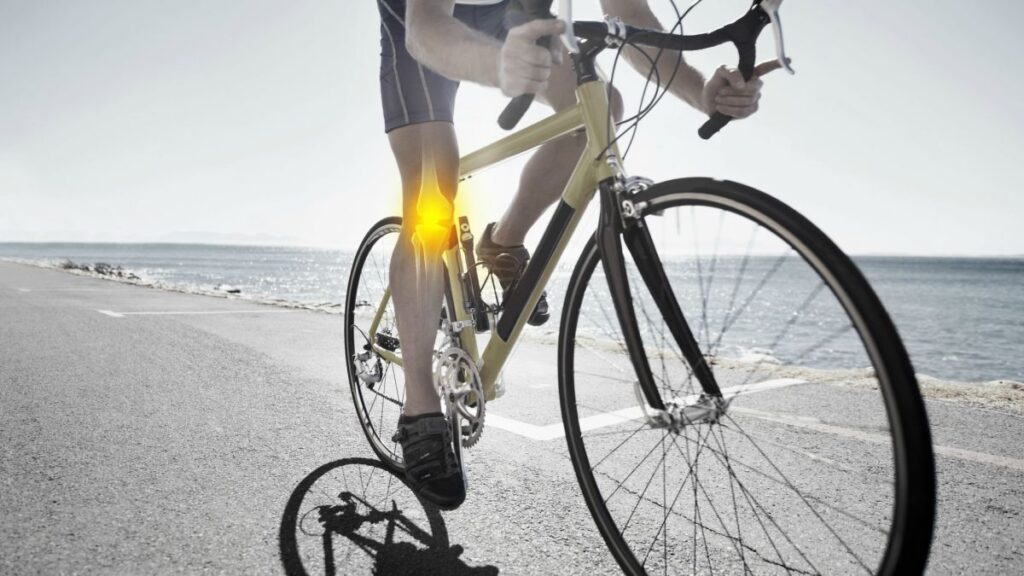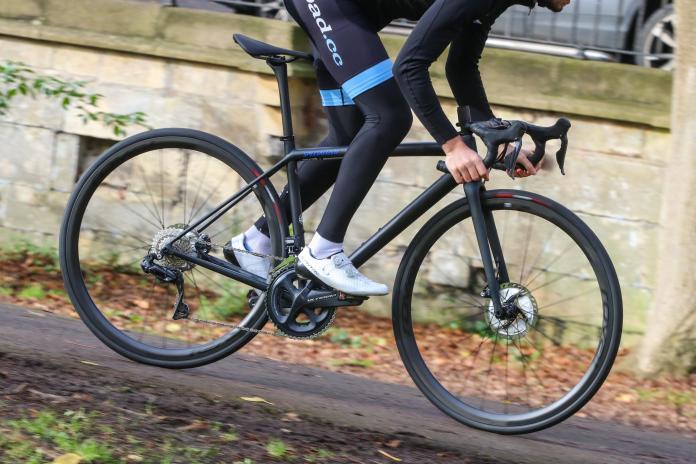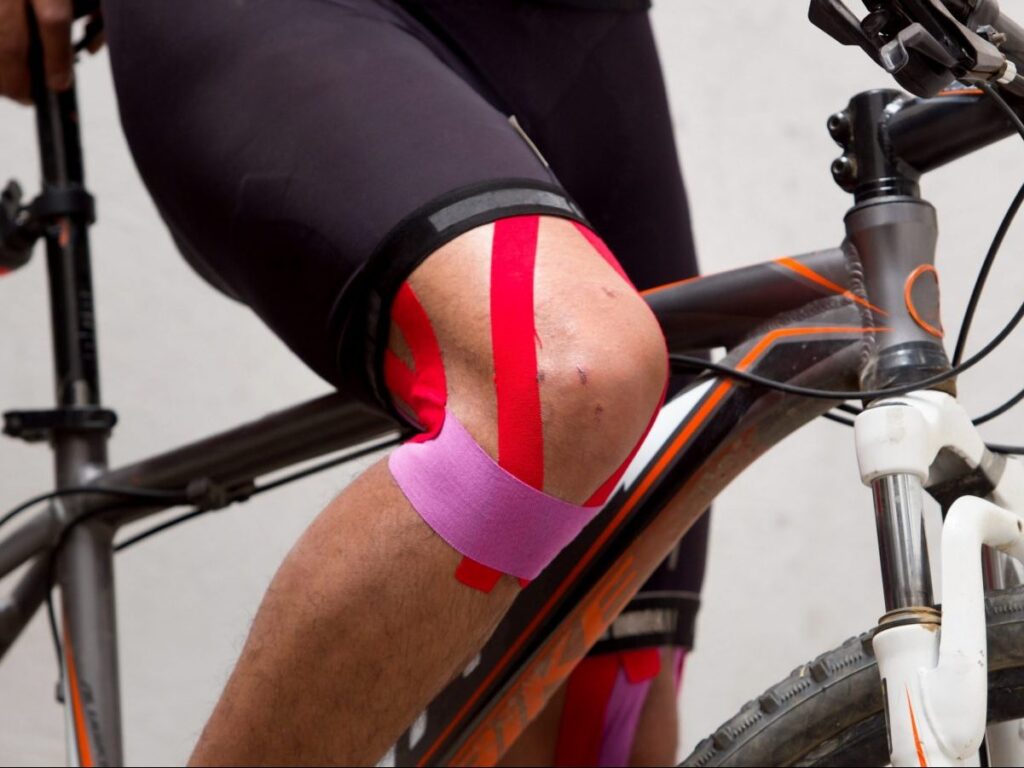


In the pursuit of fitness, a question that often looms large is whether an activity can be both invigorating and gentle on the joints. If you find yourself pondering, “Is biking good for knee pain?” the resounding answer is yes.
Cycling, with its rhythmic motion and low-impact nature, emerges as a potential solution for those seeking relief from knee discomfort.
Knee pain can be a formidable hurdle, causing apprehension towards engaging in certain exercises. This is where biking steps onto the stage, offering a unique blend of cardiovascular exercise and joint-friendly movement.
The act of cycling involves a fluid motion that minimizes impact on the knees, making it an appealing choice for individuals seeking pain relief without compromising on their fitness goals.
As we embark on this exploration, we’ll delve into the reasons behind biking’s knee-friendly reputation. From the biomechanics that makes it a gentle option to the strategies for incorporating biking into your routine, we’ll journey through the science and practicality of how this activity could potentially alleviate knee pain.
So, let’s unveil the joint-friendly world of biking, where each pedal stroke holds the promise of not just invigoration, but also relief for those battling knee discomfort.
Related: Is biking hard on knees?
Pedaling Away Knee Pain: Exploring Biking’s Benefits



Knee pain can be a daunting roadblock to an active lifestyle, making every step a reminder of discomfort. But what if there was a way to not only stay active but also potentially alleviate knee pain?
Read More : ” Can You Ride A Dirt Jumper on Trails? “
Enter biking, a low-impact exercise that offers a myriad of benefits for those seeking relief while keeping up with their fitness goals. In this article, we delve into how biking can serve as a therapeutic solution for knee pain, allowing you to pedal your way to a healthier, pain-free life.
- Low-Impact Brilliance:
Biking stands out for its low-impact nature. Unlike high-impact activities that may strain the knees, cycling involves a smooth motion that minimizes stress on the joints. This makes it an excellent option for individuals with knee issues, as it provides a way to stay active without exacerbating discomfort.
- Gentle Joint Movement:
The pedaling motion of biking involves a circular movement that doesn’t subject the knees to sudden jarring or jolts. This gentle, controlled movement encourages fluidity in the joints, promoting circulation and reducing stiffness.
- Muscle Engagement and Support:
Cycling engages a range of leg muscles, including the quadriceps and hamstrings. Stronger muscles around the knee joint provide enhanced stability and support, which can contribute to alleviating pain and reducing the risk of further strain.
- Controlled Intensity:
Whether you opt for leisurely rides or more challenging routes, cycling allows you to control the intensity of your workout. This enables you to adjust according to your comfort level, gradually building strength and endurance without overloading your knees.
- Weight Distribution:
Biking helps distribute your body weight more evenly compared to activities that put more pressure on the knees, such as running. This balanced distribution lessens the strain on the knee joints, offering relief to those dealing with pain.
- Cardiovascular Benefits:
Engaging in cardiovascular exercise is essential for overall health, and biking provides an effective way to achieve this without causing unnecessary stress on the knees. Improved cardiovascular fitness contributes to better circulation and joint health.
- Consultation and Safety:
Before beginning any new exercise routine, especially when dealing with knee pain, it’s advisable to consult a healthcare professional or physical therapist. They can provide personalized guidance and ensure that biking is a suitable option based on your specific condition.
In Conclusion:
Biking isn’t just an activity; it’s a potential solution for those grappling with knee pain. By choosing the gentle yet impactful realm of cycling, you can embark on a journey toward relief, improved joint health, and overall well-being.
Remember, each pedal stroke isn’t just moving you forward; it’s moving you toward a life where knee pain doesn’t dictate your mobility. So, saddle up, embrace the wind in your hair, and discover the transformative power of pedaling away knee pain.
Read More: Is mountain biking a good workout?
Knee-Friendly Cardio: The Case for Biking with Knee Pain



When knee pain becomes a constant companion, the idea of engaging in cardiovascular exercise can feel like an uphill battle. However, there’s a solution that combines fitness and joint relief – biking. In this article, we make a compelling case for why biking is the perfect choice for knee-friendly cardio, allowing you to reclaim an active lifestyle without aggravating discomfort.
Read More : ” Stumpjumper Comp Alloy Weight “
- The Gentle Impact of Biking
One of the primary concerns with knee pain is impact. Biking offers a smooth, low-impact motion that minimizes stress on the knee joints. The circular pedaling movement is kind to the knees, providing a cardiovascular workout without subjecting them to jarring forces.
- Muscle Engagement for Support
Strong muscles play a pivotal role in knee support. Biking engages various leg muscles, including the quadriceps and hamstrings. These muscles act as protective buffers for the knees, reducing strain and promoting joint stability.
- Range of Motion and Flexibility
The controlled motion of pedaling in biking encourages a healthy range of motion in the knee joints. It promotes flexibility and combat stiffness, making it an excellent choice for individuals seeking relief from discomfort caused by restricted movement.
- Gradual Progression
Biking allows for gradual progression, catering to individuals at various fitness levels. Whether you’re a beginner or an experienced rider, you can tailor your biking routine to your comfort. This incremental approach enables you to build strength without overexerting your knees.
- Weight Distribution Advantage
Compared to weight-bearing exercises like running, biking offers a balanced distribution of body weight. This distribution reduces pressure on the knee joints, making it a safer option for individuals dealing with knee pain.
- Cardiovascular Fitness
Cardiovascular health is essential, even for those with knee pain. Biking provides an effective cardiovascular workout that improves heart health and circulation without compromising your knees.
- Safety First: Consultation Matters
Before embarking on a biking routine, especially if you have knee pain, consult a healthcare professional or physical therapist. They can guide you on proper technique, appropriate intensity, and modifications tailored to your specific condition.
- Embrace the Journey
Biking isn’t just a mode of transportation; it’s a pathway to wellness. By choosing knee-friendly cardio through biking, you’re not just exercising; you’re fostering a healthier relationship with your body.
Each ride becomes a step towards improved joint health, reduced discomfort, and a more active lifestyle. So, grab your helmet, feel the breeze on your face, and let biking lead you on a journey of well-being and rejuvenation. Your knees will thank you for it.
Read More: Is mountain bike good for beginners?
Joint Relief in Motion: Biking’s Impact on Knee Pain



Knee pain can cast a shadow over daily activities, but the solution might be as simple as cycling. Biking isn’t just a recreational activity; it’s a therapeutic journey that can offer significant relief to those grappling with knee discomfort.
- A Unique Blend of Motion:
Biking provides a unique combination of fluid motion and controlled exertion. The circular pedaling movement offers joint relief by minimizing the impact on the knees while engaging the muscles responsible for supporting them.
- A Gateway to Flexibility:
One of the challenges of knee pain is maintaining flexibility. Biking addresses this concern by promoting a healthy range of motion in the knee joints. As you pedal, you’re gently encouraging the joints to move, reducing stiffness and enhancing overall flexibility.
- Muscle Activation for Support:
The muscles surrounding the knees play a crucial role in alleviating pain. Biking engages these muscles, particularly the quadriceps and hamstrings. By strengthening these muscle groups, you’re creating a supportive environment for your knee joints.
- Cardiovascular Fitness Without Strain:
Cardiovascular exercise is essential, even when dealing with knee pain. Biking offers a way to elevate your heart rate without subjecting your knees to high-impact stress. It’s a win-win scenario – improved cardiovascular health and joint relief.
- Gradual Progress, Long-Term Benefits:
Whether you’re a beginner or an experienced cyclist, biking allows for gradual progression. You can adjust the intensity according to your comfort level, building strength, and endurance over time without overburdening your knees.
- A Connection to Nature and Wellness:
Biking is more than just a physical activity; it’s a connection to nature and a release of endorphins that contribute to overall well-being. The combination of fresh air, movement, and the thrill of the ride can positively impact your mental and emotional state.
- Consultation for a Safe Start:
Before starting any new exercise routine, especially with knee pain, it’s wise to consult a healthcare professional. They can offer personalized advice, ensuring that biking is suitable for your specific condition and guiding you on the right techniques.
In Conclusion
As you explore avenues for knee pain relief, don’t overlook the simple joy of biking. The rhythm of pedaling, the wind against your face – it’s not just a physical experience; it’s a journey towards joint relief in motion. Biking offers a holistic approach to wellness, addressing both the physical and mental aspects of health. So, grab your bike, embrace the path ahead, and let joint relief become a part of your active lifestyle.
Read More: Does biking help lose belly fat?
Saddle Up for Knee Health: How Biking Eases Discomfort



Knee pain can cast a shadow over daily activities, but the solution might be as simple as cycling. Biking isn’t just a mode of transportation; it’s a pathway to improved knee health and joint relief. In this article, we delve into the ways biking can be your ally in easing knee discomfort and fostering overall well-being.
Read More: Is mtb good for commuting
The Cycling Advantage for Knee Health
- Gentle Fluidity:
Biking’s circular pedaling motion is a boon for knees. Unlike high-impact activities, it offers a controlled and fluid movement that reduces strain on the joints.
- Muscle Support:
Biking engages key leg muscles like the quadriceps and hamstrings. Strengthening these muscles adds an extra layer of support to the knee joints, aiding in pain management.
- Low-Impact Cardio:
Maintaining cardiovascular fitness is essential, especially when dealing with knee pain. Biking provides an efficient cardio workout without compromising joint health.
The Journey of Gradual Progression
- Comfortable Progression:
Biking allows for gradual advancement. Beginners can start with shorter rides and increase intensity as their strength improves, avoiding undue stress on the knees.
Balanced Weight Distribution
- Equal Distribution:
Unlike weight-bearing exercises, biking distributes body weight evenly. This alleviates pressure on the knee joints, providing relief from discomfort.
Holistic Wellness and Consultation
- Mind-Body Connection:
Beyond the physical benefits, biking offers a mental release. The outdoor experience, fresh air, and connection with nature contribute to overall well-being.
- Professional Guidance:
Consulting a healthcare professional is vital before beginning any new exercise routine, especially with knee pain. They can provide personalized advice and ensure that biking aligns with your condition.
A Final Push for Comfort and Vitality
In your quest for knee health, consider biking as more than just an activity. It’s a journey that can lead to improved joint comfort, enhanced muscle support, and a stronger cardiovascular system. Each pedal stroke becomes a step towards a healthier you, promoting not only knee well-being but also a holistic sense of vitality and joy.
So, embrace your bike, explore the path ahead, and saddle up for a ride towards knee health and a more active, fulfilling life.
Read More: Is mountain bike good for long rides?
Biking Through Pain: Can It Help Your Knees?



The fitness journey can often intersect with the challenges of knee pain. It’s a conundrum: wanting to stay active but fearing aggravation. The solution might lie in an unexpected place – biking. In this article, we dive deep into the question of whether biking through pain can truly be a remedy for your knees.
Knee Pain’s Paradox: To Move or Not to Move?
- The Conundrum:
Knee pain can create a dilemma. Moving seems daunting, but staying sedentary may worsen the condition. Is biking a solution or a risk?
The Science Behind Biking’s Potential
- Low-Impact Savior:
Biking is a low-impact exercise. The circular pedal motion minimizes stress on the knees while engaging muscles that provide support.
- Joint Lubrication:
Regular cycling promotes the release of synovial fluid, which lubricates joints. This can contribute to reducing friction and easing discomfort.
Navigating the Fine Line
- Comfort-Based Approach:
Biking through pain requires careful navigation. Start with shorter rides at a comfortable pace, gradually increasing intensity as your knees adapt.
- Muscle Strengthening:
Engaging leg muscles during cycling helps build support around the knee joints. This strength can alleviate discomfort and reduce the risk of injury.
The Holistic Impact
- Mental and Emotional Gains:
Biking offers more than physical benefits. It provides a mental escape and a sense of accomplishment, contributing to overall well-being.
- Consulting the Expert:
Before embarking on a biking routine, consult a healthcare professional. They can provide personalized advice and help determine if biking is appropriate for your specific condition.
Redefining the Pain Paradigm
In the journey of biking through pain, it’s important to distinguish between discomfort and actual harm. Biking can offer a way to move, engage muscles, and foster a sense of accomplishment, even when dealing with knee discomfort.
As you pedal through the challenge, remember that each rotation is an assertion of your commitment to wellness. While the decision to bike through pain rests on individual circumstances, the potential benefits for your knees and overall health are worth considering.
So, saddle up, embark on the path of exploration, and find out if biking through pain can indeed be a step towards healing and a more active lifestyle.
Read More: What do I need to start mountain biking?
Cycling Solutions: Managing Knee Pain with Biking



Knee pain can be a formidable adversary, but the solution might be closer than you think – your bicycle. In this article, we unravel the world of “Cycling Solutions,” exploring how biking can become a strategic tool in managing and even mitigating knee pain.
Understanding the Knee Pain Puzzle
- Pain’s Puzzle:
Knee pain presents a puzzle. Can an activity as dynamic as cycling hold the key to managing discomfort?
Biking’s Role in Knee Health
- Low-Impact Advantage:
Biking’s fluid motion minimizes joint impact, making it an ideal exercise for those with knee pain. The circular pedal motion offers a gentle rhythm that reduces stress.
- Muscle Support:
Engaging leg muscles during biking strengthens the quadriceps and hamstrings, providing vital support to the knee joints and potentially easing pain.
Crafting a Biking Strategy
- Start Slow:
Begin with shorter, low-intensity rides to allow your knees to adapt. Gradually increase duration and intensity as your comfort level improves.
- Proper Form Matters:
Correct bike fit and posture are crucial. Improper alignment can exacerbate knee pain, while proper form can enhance joint comfort.
The Comprehensive Approach
- Complement with Strength Training:
Combine biking with targeted exercises to strengthen muscles around the knee. A balanced approach can help alleviate pain and enhance joint stability.
- Consultation and Guidance:
Before embarking on a biking regimen, consult a healthcare professional. They can assess your condition, offer tailored advice, and ensure that biking aligns with your needs.
Pedaling Towards Comfort
Managing knee pain is a multifaceted endeavor, and biking can play a significant role in this journey. As you pedal, you’re not just moving forward; you’re moving towards a realm where knee pain takes a backseat. The rhythm of cycling, the strengthening of support muscles, and the sheer joy of movement can collectively contribute to knee comfort and overall wellness.
While every individual’s situation is unique, exploring the potential of biking as a solution to knee pain could lead you down a path of increased mobility, vitality, and a renewed love for the open road. So, saddle up, embark on this cycling solution, and let your journey toward knee comfort begin.
Read More: How to ride a mountain bike for beginners?
The Science of Support: Why Biking Is Kind to Your Knees



In the realm of fitness, knee pain can feel like an unwelcome companion. But what if there was a way to not only stay active but also potentially alleviate discomfort? Enter biking – a mode of exercise that intertwines biomechanics and joint health.
In this article, we delve into the intricate science behind why biking is exceptionally kind to your knees.
The Biomechanics Behind Biking’s Kindness
- A Harmonious Motion:
Biking’s circular pedaling motion is inherently knee-friendly. The continuous movement minimizes abrupt impacts, reducing stress on the knee joints.
Muscle Engagement: A Protective Shield
- The Muscle Symphony:
Engaging the quadriceps, hamstrings, and calf muscles during biking provides a dynamic support system for the knee joints. Strong muscles offer stability and cushioning.
Even Weight Distribution: A Balancing Act
- Weight-Bearing Advantage:
Biking distributes body weight evenly, sparing the knees from the disproportionate pressure often experienced during activities like running.
Gentle Cardiovascular Fitness
- The Cardiovascular Connection:
Cardiovascular exercise is essential for overall health, and biking provides a way to achieve it without causing undue strain on the knees.
Preservation of Cartilage and Lubrication
- Synovial Secret: Lubrication in Action:
Regular biking stimulates the release of synovial fluid, a natural lubricant for the joints. This lubrication eases movement and minimizes friction.
Impact Reduction: A Favorable Equation
- Impact-Reduced Environment:
Biking on surfaces like asphalt or trails is less jarring than high-impact activities. This mitigates wear and tear on the knees, promoting joint health.
Consultation and Customization
- Personalized Approach:
Consult with a healthcare professional before incorporating biking into your routine, especially if you’re dealing with existing knee issues. Their expertise ensures a tailored approach.
The Beautiful Symmetry of Biking
Biking isn’t just a mechanical activity; it’s a harmonious symphony of biomechanics and joint support. As you pedal, you’re not merely moving forward; you’re fostering a delicate balance between movement and protection.
By engaging muscles, distributing weight, and minimizing impact, biking emerges as a graceful solution for those seeking knee comfort without compromising on fitness. While every individual’s journey is unique, the science is clear – biking can be a kind and empowering path towards healthier knees and a more active, fulfilling life.
So, embrace the bike, explore the science, and let the symphony of support guide your knees toward a brighter, pain-free horizon.
Read More: How to ride switchbacks on a mountain bike?
Pain-Free Progress: Embracing Biking for Knee Pain Relief



Knee pain can cast a shadow over everyday activities, but the pursuit of relief often leads us to surprising solutions. Biking, once reserved for leisure, has emerged as a potential ally in the battle against knee discomfort.
In this article, we dive into the world of “Pain-Free Progress” through biking – a journey that not only offers relief but also promotes well-being.
The Challenge of Knee Pain
- The Struggle with Discomfort:
Knee pain poses challenges that impact mobility and quality of life. Can biking, an enjoyable pastime, truly hold the key to relief?
Biking’s Unique Attributes for Knee Relief
- A Symphony of Motion:
Biking’s circular pedal motion is a symphony of relief for knee discomfort. This gentle movement minimizes impact while engaging muscles that offer support.
- Strength in Unity:
Engaging the muscles around the knee joint – the quadriceps, hamstrings, and calves – provides stability. These muscles act as a protective shield against pain.
Progress at Your Pace
- Gradual Progression:
Biking offers flexibility in intensity and duration. Start with short, gentle rides and gradually increase as your comfort level improves.
Biking’s Holistic Impact
- Mental and Emotional Well-Being:
Biking offers more than just physical relief. The outdoor experience, the sense of accomplishment, and the freedom of movement contribute to overall well-being.
- A Community of Support:
Joining cycling communities can provide encouragement, motivation, and shared experiences that enhance your journey toward knee pain relief.
Guided and Informed Approach
- Consultation for Safety:
Before incorporating biking into your routine, consult a healthcare professional. Their guidance ensures that biking aligns with your condition.
A Path to Pain-Free Progress
Embracing biking for knee pain relief isn’t just about the act of pedaling; it’s about discovering a newfound sense of freedom. As you ride, you’re not just moving forward; you’re progressing toward a life with less discomfort and more vitality.
Each turn of the pedal is a step towards regaining mobility, fostering strength, and embracing a sense of empowerment over knee pain. While the journey may have its unique challenges, the promise of pain-free progress through biking is an invitation to experience life with renewed vigor.
So, saddle up, embark on this path of relief, and let the pedals guide you toward a future where knee pain no longer holds you back.
Read More: Are mountain bikes harder to pedal?
Conclusion:
In the quest for knee pain relief, the answer to the question “Is biking good for knee pain?” resounds with a resounding affirmation. Through the intricate interplay of biomechanics, muscle engagement, and joint support, biking emerges as a gentle yet impactful ally in the battle against discomfort.
It’s not merely about the act of pedaling; it’s about embracing a solution that fosters pain-free progress and promotes overall well-being.
From the soothing circular motion that minimizes impact to the strengthening of muscles that cushion and protect, biking unveils its potential as a supportive companion on your journey toward knee health. It’s a journey of balance, where each pedal stroke becomes a testament to your determination to overcome pain and embrace an active lifestyle.
As the wind brushes against your face and the rhythmic motion becomes your anthem, remember that biking isn’t just an activity; it’s a remedy, a release, and a revelation. It’s the symphony of science and motion that harmonizes with your body’s needs.
So, whether you’re a novice rider or an experienced cyclist, whether you’re seeking relief or striving for vitality, biking is indeed good for knee pain. It’s a journey that holds the promise of pain-free progress, an affirmation of strength, and a declaration that knee pain doesn’t define your mobility – you do.
FAQs:
How much cycling is good for knee pain?
Start with 15-30 minutes of gentle cycling, gradually increasing time and intensity as comfort improves. Listen to your body and consult a professional for personalized guidance.
Is bike riding hard on the knees?
Bike riding is generally gentle on the knees due to its low-impact nature. Proper bike setup, form, and gradual progression can help minimize any potential strain.
Which is better for knees biking or walking?
Biking is often gentler on knees than walking due to its low-impact nature. However, both can be beneficial with proper technique and gradual progression.
Which is better for knees biking or walking?
Both biking and walking can be knee-friendly exercises, but biking is typically gentler due to its low-impact nature. Consult your doctor for personalized advice.
Why do my knees hurt after a bike ride?
Knee pain after a bike ride can result from improper bike setup, poor riding technique, or overuse. Ensure proper bike fit and consider consulting a professional for guidance.



Welcome to Bikegenics, where passion meets performance! We are a leading online destination for all things related to mountain biking, dedicated to providing you with top-notch gear, expert advice, and an immersive community to fuel your two-wheeled adventures. With a commitment to excellence and a deep love for the sport, we strive to elevate your biking experience to new heights.
